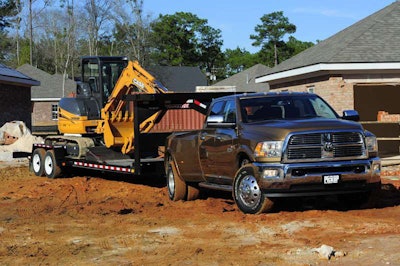
New Duallys Costing Companies More Than Just Price Of Purchase
Rising tow ratings on today’s heavy-duty pickups well into GCWRs that require drivers get CDLs
One of Ron Huston’s jobs as the engineering supervisor for Minnesota-based Polaris Industries used to be just making sure all the company trailers and duallys they use to move ATVs and equipment around the country for testing and training were in top working order.
When the truck’s started getting high miles, they’d be swapped out for the newest model as a normal cost of doing business.
These days the dozen or more duallys in their fleet are 2012-newer and have all the amenities and power to easily handle the company’s double- and triple-axle gooseneck trailers that usually weigh less than 15,000 pounds fully loaded.
RELATED: More About Pickup CDLs
But Ron now has to make sure every one of his drivers has a CDL. It’s an added corporate cost that’s the result of today’s hardest working trucks getting bigger and better.
“Not everyone that drives a dually needs a CDL,” says Steve Duea, one of the Polaris dealer/sales trainers who has more than 35,000 miles on his 2013 Silverado 3500HD dually pulling a custom 44-foot enclosed trailer for the company.
“But the moment you hook up a trailer that has a Gross Vehicle Weight Rating (GVWR) of more than 14,000 pounds to a truck with a 13,000-pound GVWR, you are in CDL country in most states,” explains Duea.
“Then you are subject to many of the same rules and regulations as big rigs, including having a valid [CDL] driver’s license, keeping logbooks and hitting the scales.”
 Towing equipment behind today’s dually pickups probably requires the driver to have a valid CDL. (Photo by Bruce W. Smith/HWT)
Towing equipment behind today’s dually pickups probably requires the driver to have a valid CDL. (Photo by Bruce W. Smith/HWT)Most contractors are towing equipment trailers of one sort or another and they do so without giving a second thought about their drivers’ licenses. That could be a costly mistake for those who towing longer double- and triple-axle trailers.
It doesn’t matter if the trailer in-tow is empty or loaded. Remember, it’s the combination of the pickup’s and trailer’s GVWR tags—not scale weight.
Both Huston and Duea warn contractors and commercial business owners that getting dually drivers their CDL is far cheaper than paying four-digit fines that can come with violating the Federal Motor Carrier laws.
Duea, who has been towing big trailers behind duallys for years, says the company paid for him to download a special CDL study kit he found online for less than $80.
He then spent the better part of three days doing nothing but studying before taking the written “Class A” driving test for “Combo/Air Brake Restricted” and “Doubles.”
Those were followed by the driving test in the same pickup and trailer that he normally drives.
“If you are familiar with driving a big pickup pulling a gooseneck or 5th wheel, it’s really not that difficult to get your Class A combo license,” says Duea. “It’s a pain having to deal with the paperwork, inspections and scales. But it’s the law.”








